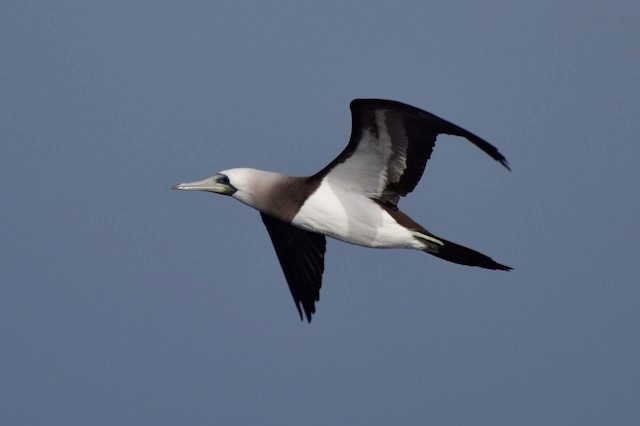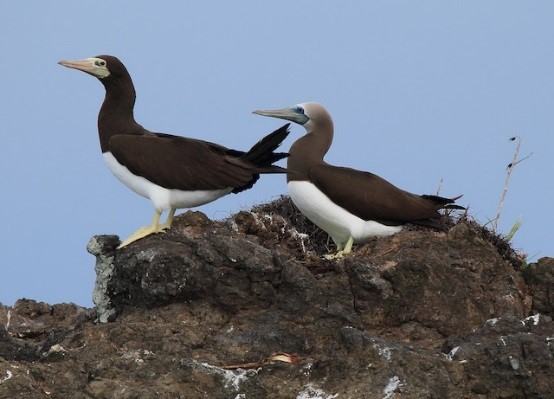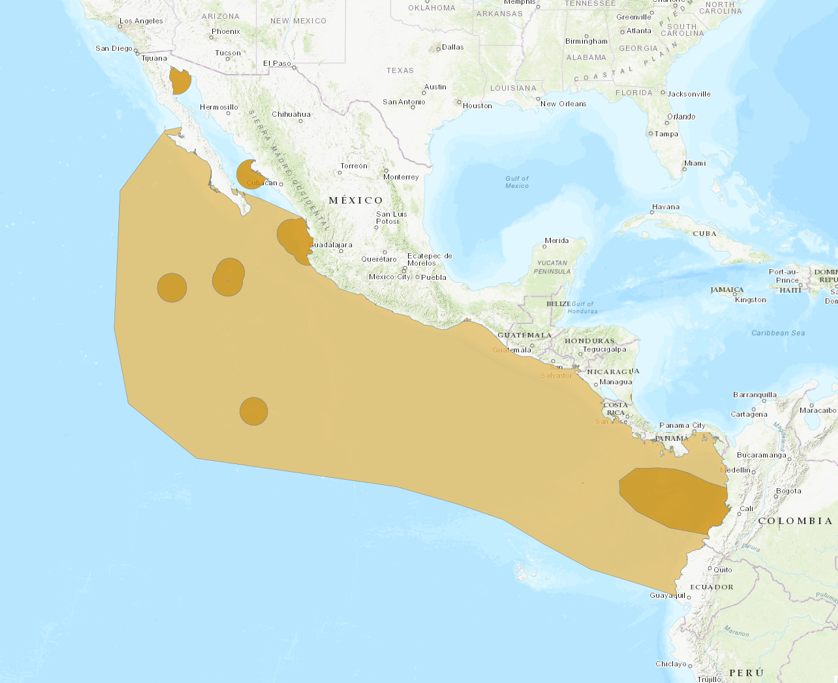Birdfinding.info ⇒ The eastern Pacific form of Brown Booby is common and familiar along much of Mexico’s coastline, including the Gulf of California (e.g., Puerto Peñasco, La Paz, and the Faro de Mazatlán) and popular resort towns such as Puerto Vallarta, Manzanillo, Zihuatanejo, and Puerto Angel, where it often perches on ships, buoys, and other nautical infrastructure. It is also locally common along the coasts of Costa Rica, Panama, and Colombia. A few are present most years in coastal California waters, especially around San Diego in September and October.
“Brewster’s Booby”
Sula leucogaster brewsteri
Tropical eastern Pacific Ocean, where it occurs in both coastal and offshore waters.
Breeding. Brewsteri breeds on Mexican islands from Los Coronados and the north end of the Gulf of California south to Guerrero, the Revillagigedos, and Clipperton.
Etesiaca breeds on islands along the Pacific Coast of Central America and Colombia from Nicaragua’s Islas Farallones south to Isla Gorgona, and on Cocos Island (Costa Rica).
Nonbreeding. Largely resident around its breeding areas, but also disperses more widely across the tropical eastern Pacific Ocean from southern California to Ecuador.
Stragglers regularly wander north to British Columbia and southeastern Alaska, south to the Galápagos, northwestern Peru, and Easter Island, and west to Hawaii and Palmyra Atoll—where up to 20 individuals have been counted together.
More exceptional vagrants have been recorded west to Japan, Saipan, and the Aleutians, and at various inland reservoirs in the southwestern U.S.
Identification
Similar to the other forms of Brown Booby: dark brown overall, with a crisply defined bright white belly and underwing linings, and pale bill and feet. Females of the three forms are nearly identical, with only subtle differences in bare parts coloration and underwing pattern, while the males are much more distinctive.
Male “Brewster’s” is the most distinctive, as it has a contrastingly pale head: white on the face and shading progressively to dark brown on the neck.

“Brewster’s Booby,” S. l. etesiaca, male. (Punta Salsipuedes, Puntarenas, Costa Rica; March 7, 2020.) © Irene Domhoff
The extent of the pale head plumage varies. In some individuals (more prevalent in the Mexican brewsteri rather than the more southerly etesiaca populations), the entire head and most of the neck are pale.
The male’s facial skin is dark blue, which contrasts with the white facial plumage and gives it a masked appearance.
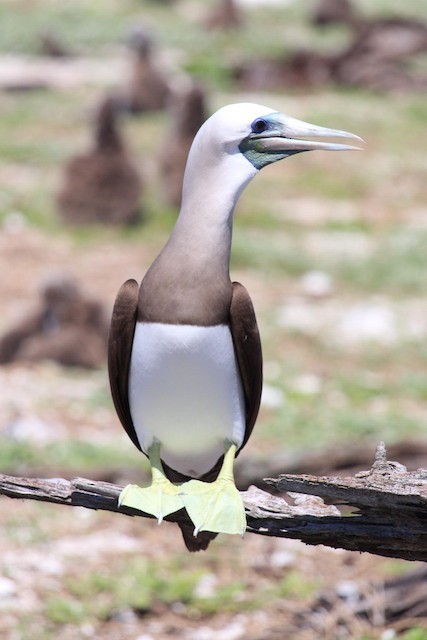
“Brewster’s Booby,” S. l. brewsteri, male. (Eastern Island, Midway Atoll National Wildlife Refuge, Midway Islands; April 9, 2017.) © Lonnie Sullivan

“Brewster’s Booby,” S. l. etesiaca, male. (Offshore from Punta Marenco, Puntarenas, Costa Rica; November 17, 2008.) © Brian Sullivan
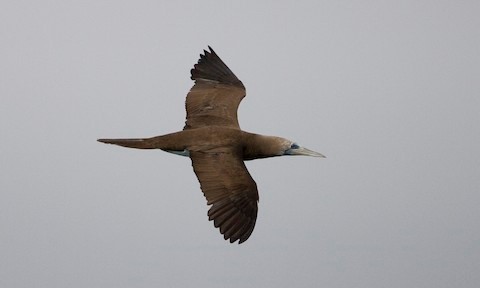
“Brewster’s Booby,” S. l. etesiaca, male with nearly all-brown head. (Offshore from Punta Marenco, Puntarenas, Costa Rica; November 17, 2008.) © Brian Sullivan
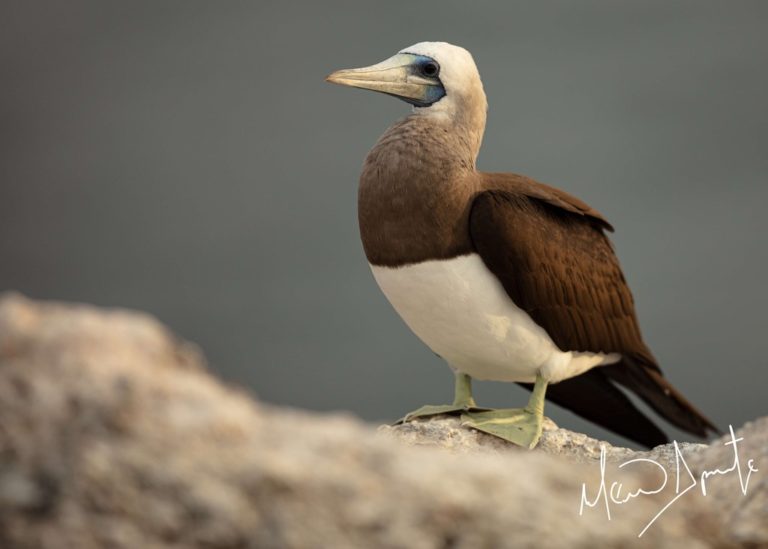
“Brewster’s Booby”, S. l. brewsteri, male. (Isla Isabel National Park, Nayarit, Mexico; December 9, 2017.) © Guillermo Aponte
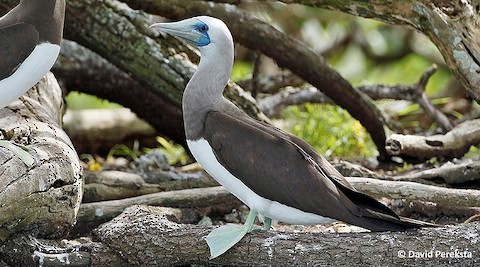
“Brewster’s Booby”, S. l. brewsteri, male. (Palmyra Atoll National Wildlife Refuge, Line Islands; November 27, 2015.) © David Pereksta
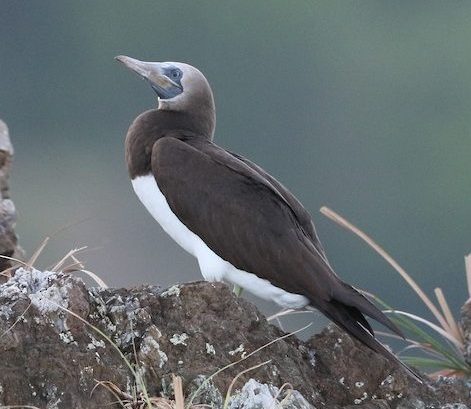
“Brewster’s Booby,” S. l. etesiaca, male. (Islas Violincitas, Puntarenas, Costa Rica; March 24, 2017.) © Jeff Tingle

“Brewster’s Booby”, S. l. brewsteri, male with nestling. (Isla Pajarera, Jalisco, Mexico; June 22, 2009.) © Martín Sánchez Vilchis
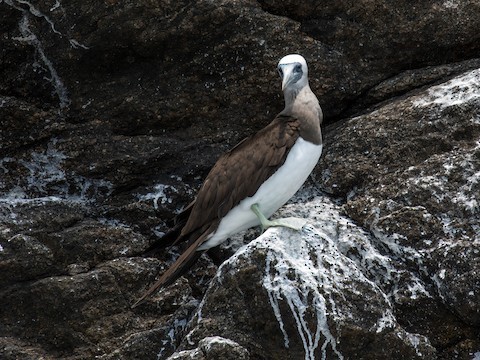
“Brewster’s Booby”, S. l. brewsteri, male. (Puerto Angel, Oaxaca, Mexico; March 25, 2017.) © Nick Athanas

“Brewster’s Booby”, male. (Offshore from Tapachula, Chiapas, Mexico; October 30, 2015.) © Moe Bertrand

“Brewster’s Booby”, S. l. brewsteri, male. (Northwest Pacific Ocean, 190 nautical miles west of Kure Atoll; September 23, 2017.) © Adam Ü
Female “Brewster’s” typically has a pale pinkish bill, pale greenish-yellow facial skin with a dark spot in front of the eye, and pale greenish-yellow feet.

“Brewster’s Booby”, S. l. brewsteri, female and male (on nest). (Isla Tortuga, Baja California Sur, Mexico; March 16, 2020.) © Valeria Huerta
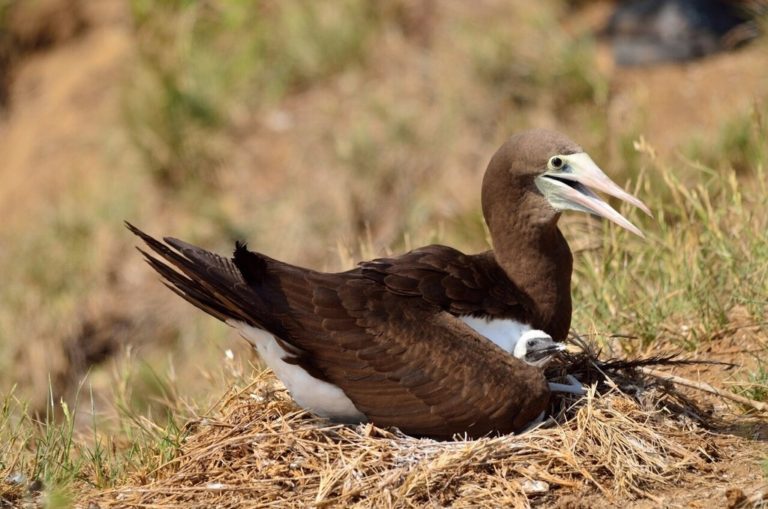
“Brewster’s Booby”, S. l. brewsteri, female. (Isla Pajarera, Jalisco, Mexico; December 29, 2017.) © alexordorica

“Brewster’s Booby,” S. l. etesiaca, female. (Offshore from Punta Marenco, Puntarenas, Costa Rica; November 17, 2008.) © Brian Sullivan
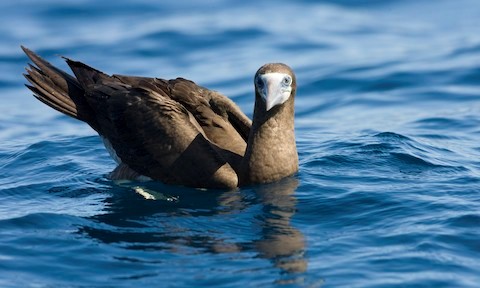
“Brewster’s Booby,” S. l. etesiaca, female. (Offshore from Playa Hermosa, Guanacaste, Costa Rica; November 12, 2008.) © Brian Sullivan
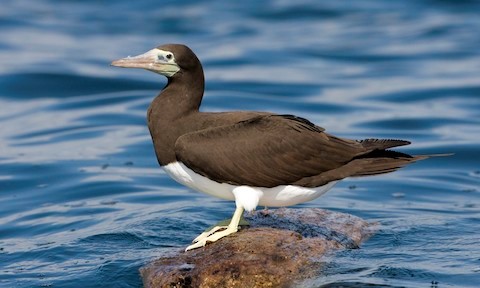
“Brewster’s Booby”, S. l. etesiaca, female. (Playa Hermosa, Guanacaste, Costa Rica; November 11, 2008.) © Brian Sullivan
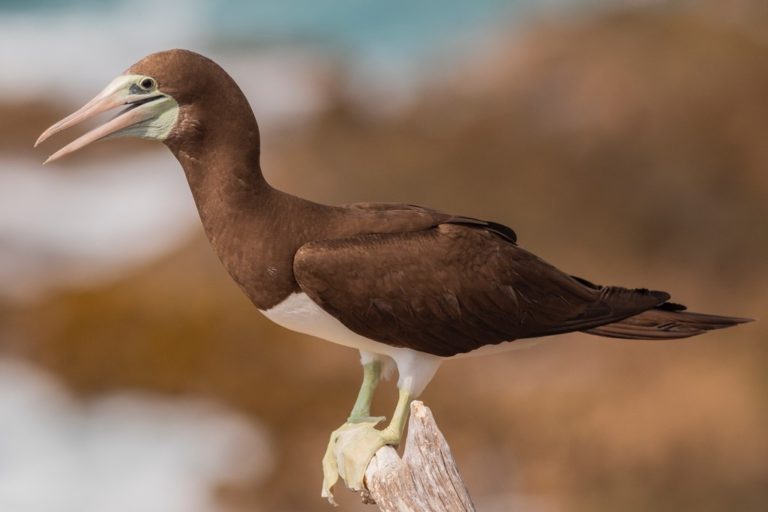
“Brewster’s Booby”, S. l. brewsteri, female. (Isla Pajarera, Jalisco, Mexico; September 22, 2019.) © world_lineage
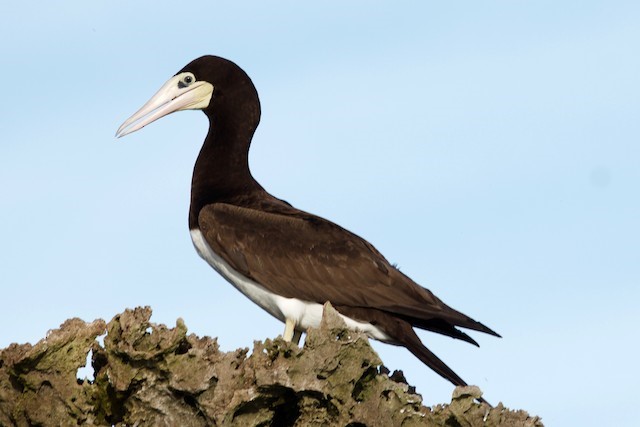
“Brewster’s Booby,” S. l. etesiaca, female. (Swan Cay, Panama; September 8, 2018.) © Natalia Decastro González

“Brewster’s Booby”, S. l. brewsteri, female. (Isla Isabel National Park, Nayarit, Mexico; February 8, 2018.) © James Thompson

“Brewster’s Booby,” S. l. brewsteri, female. (Isla Isabel National Park, Nayarit, Mexico; December 13, 2017.) © Edward Jordan
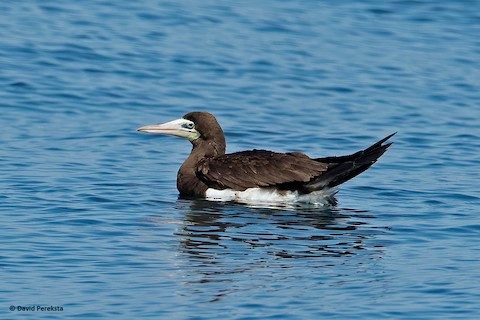
“Brewster’s Booby”, S. l. brewsteri, female. (Lausen Seamount, offshore from Laguna Beach, California; September 18, 2020.) © David Pereksta
In flight, the underwing is mostly dark-brown, and the coverts are white near the body, then mostly dark with a narrow white central strip extending out to the wrist—usually with a thin dark streak across the middle of the coverts. This irregular pattern is sometimes useful in distinguishing female “Brewster’s” from “Forster’s”, which has more extensively white underwing coverts.
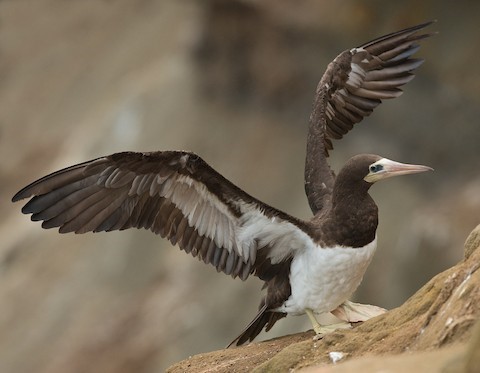
“Brewster’s Booby”, S. l. brewsteri, female. (Goldfish Point, La Jolla, California; January 10, 2016.) © Barbara Swanson
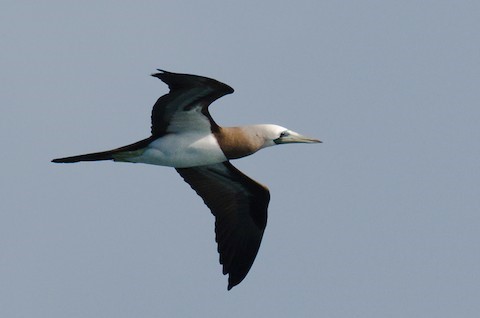
“Brewster’s Booby”, S. l. brewsteri, male. (Pauwalu Point Wildlife Sanctuary, Maui, Hawaii; February 1, 2020.) © Zeke Smith

“Brewster’s Booby”, S. l. etesiaca, male. (Bahía Solano, Chocó, Colombia; May 24, 2019.) © amendozalu
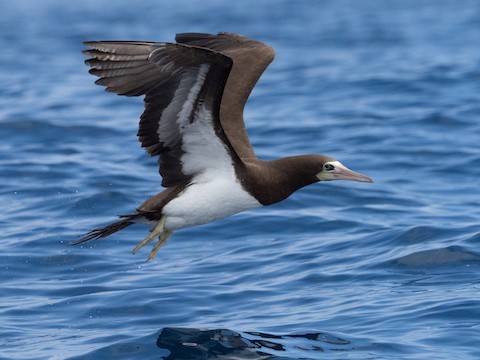
“Brewster’s Booby”, S. l. brewsteri, female, showing distinctive pattern on underwing secondary coverts. (Lower Nine Mile Bank, offshore from San Diego, California; May 28, 2021.) © Owen Sinkus
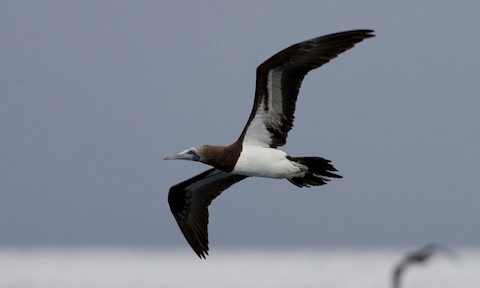
“Brewster’s Booby,” S. l. etesiaca, male. (Offshore from Punta Marenco, Puntarenas, Costa Rica; November 17, 2008.) © Brian Sullivan
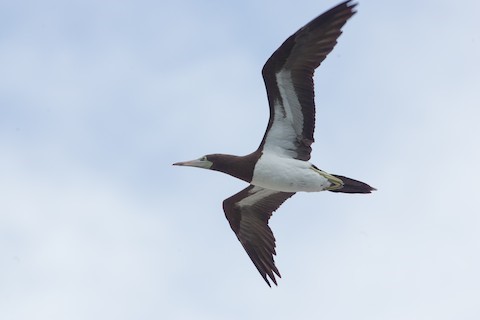
“Brewster’s Booby”, S. l. brewsteri, female. (Isla Peña Blanca, Colima, Mexico; February 2, 2005.) © Simon Colenutt
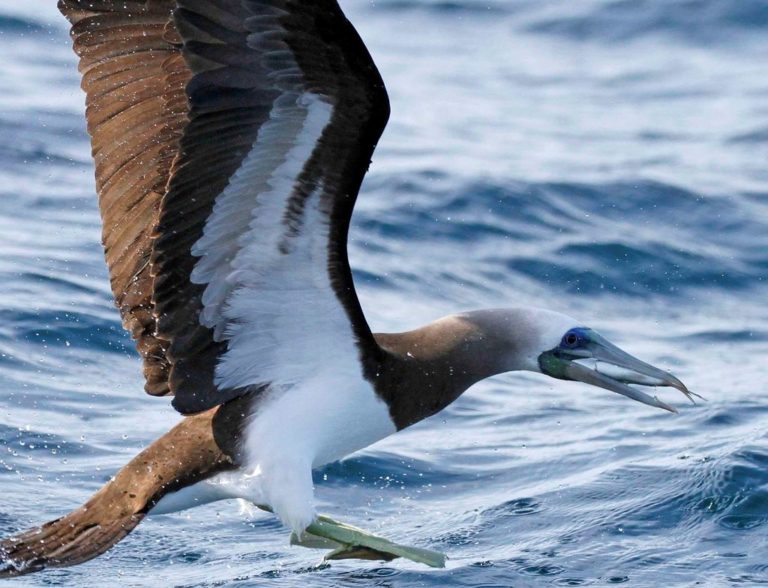
“Brewster’s Booby”, S. l. brewsteri, male. (San Carlos, Sonora, Mexico; April 8, 2015.) © mlwatson
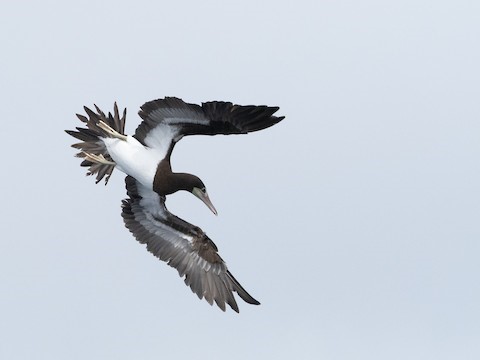
“Brewster’s Booby,” S. l. brewsteri, female. (Lower Nine Mile Bank, offshore from San Diego, California; May 28, 2021.) © Owen Sinkus
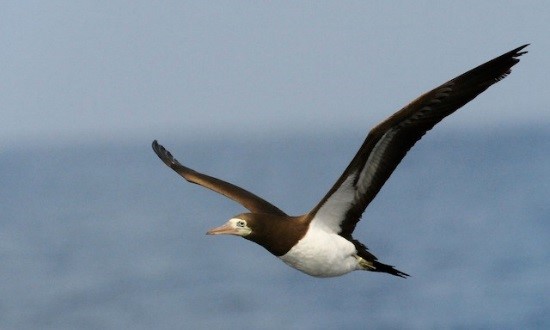
“Brewster’s Booby,” S. l. etesiaca, female. (Offshore from the Nicoya Peninsula, Costa Rica; November 21, 2010.) © Luke Seitz

“Brewster’s Booby,” S. l. brewsteri, female. (Santa Barbara Island, California; July 12, 2020.) © Alexander Viduetsky
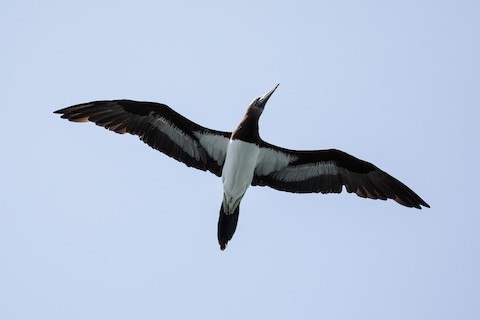
“Brewster’s Booby”, S. l. brewsteri, male. (Puerto Angel, Oaxaca, Mexico; March 25, 2017.) © Nick Athanas

“Brewster’s Booby”, S. l. brewsteri, male. (Marina Vallarta, Puerto Vallarta, Jalisco, Mexico; December 21, 2016.) © Cole Gaerber
Immature Plumages. Before attaining full adult plumage, “Brewster’s Boobies” go through a progression of changes in plumage and bare parts coloration.
Juveniles are almost entirely medium-to-dark brown with a dark-gray bill and facial skin.
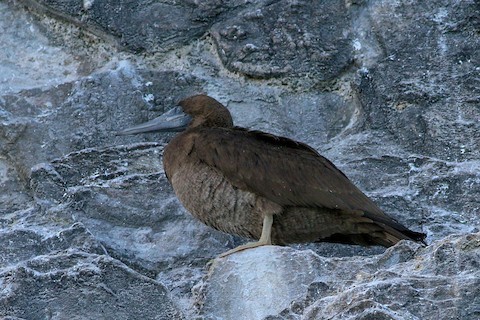
“Brewster’s Booby,” S. l. brewsteri, juvenile. (Elephant Rock, Nayarit, Mexico; March 31, 2017.) © Skip Russell
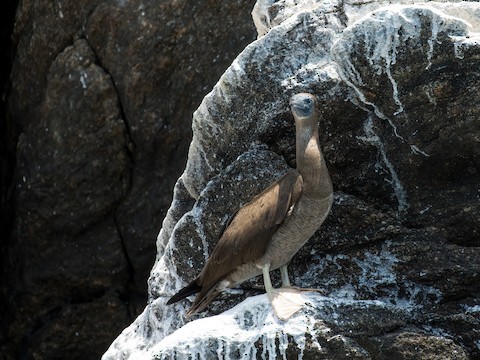
“Brewster’s Booby”, S. l. brewsteri, immature. (Puerto Angel, Oaxaca, Mexico; March 25, 2017.) © Nick Athanas
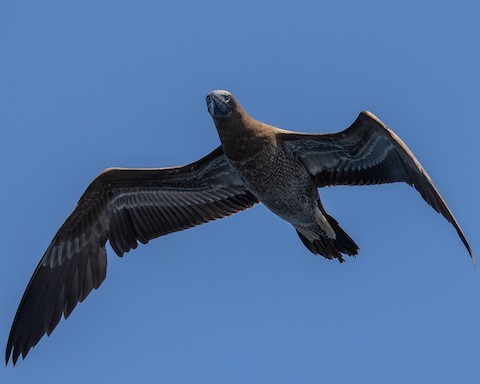
“Brewster’s Booby”, S. l. brewsteri, immature. (Offshore from Newport Beach, California; May 1, 2020.) © Kristin Campbell
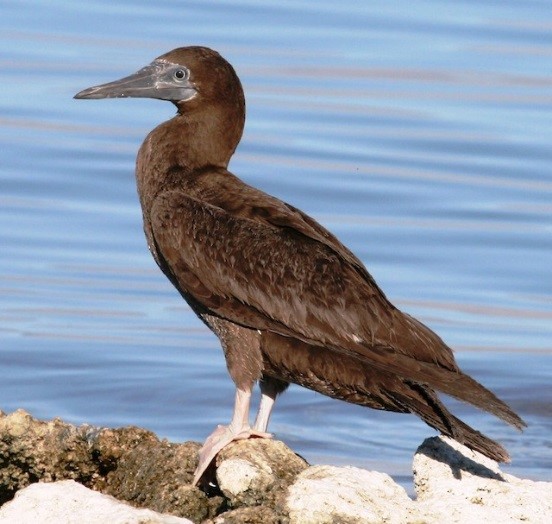
“Brewster’s Booby,” S. l. brewsteri, juvenile. (Salton Sea State Recreation Area, California; September 3, 2010.) © Tom Benson
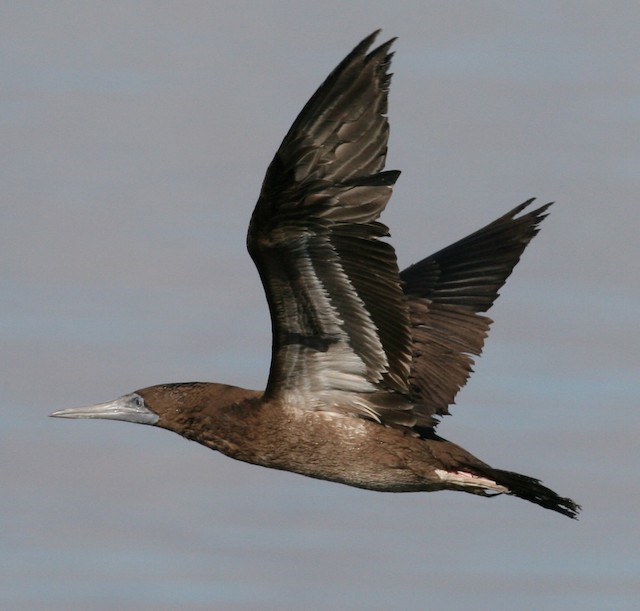
“Brewster’s Booby,” S. l. brewsteri, juvenile. (Salton Sea State Recreation Area, California; September 3, 2010.) © Tom Benson
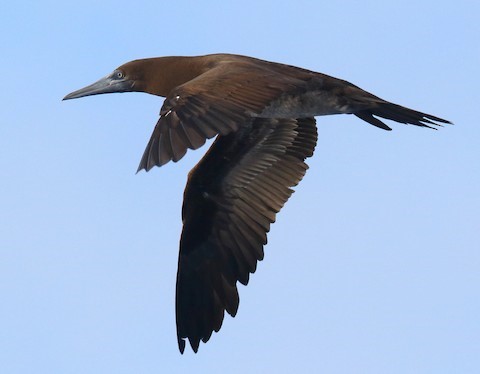
“Brewster’s Booby”, S. l. brewsteri, immature. (Offshore from San Diego, California; October 21, 2018.) © Greg Gillson
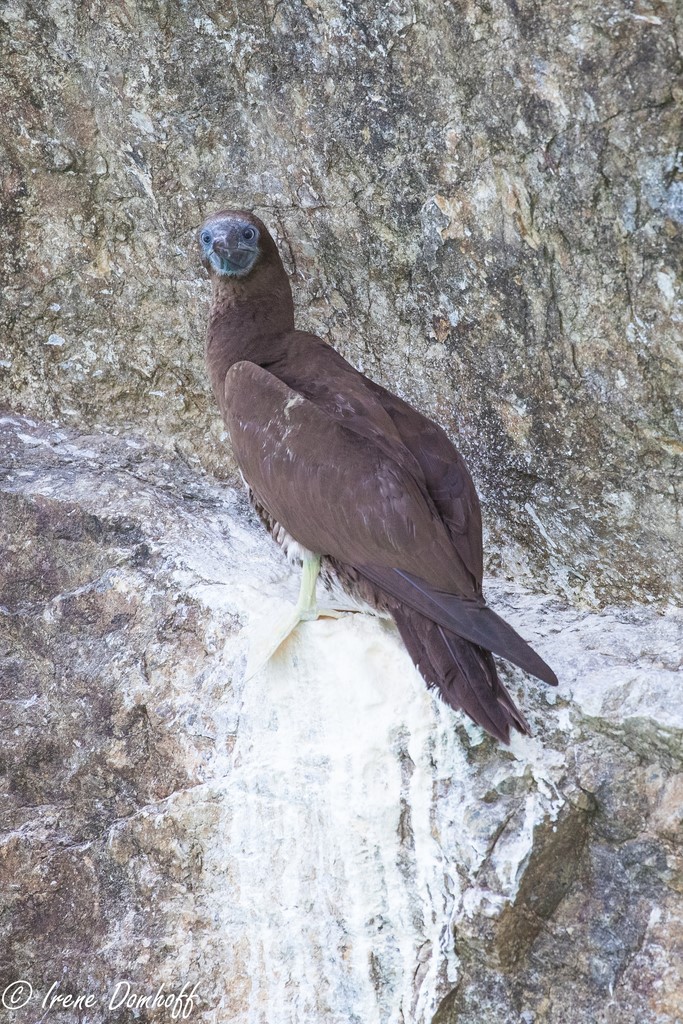
“Brewster’s Booby,” S. l. etesiaca, immature. (Punta Salsipuedes, Puntarenas, Costa Rica; March 7, 2020.) © Irene Domhoff

“Brewster’s Booby,” S. l. etesiaca, immature. (Punta Salsipuedes, Puntarenas, Costa Rica; March 7, 2020.) © Irene Domhoff
As they age, the belly and underwing linings become progressively whiter, and the face and bill lighten. A pronounced line of demarcation between the solid brown chest and paler (eventually white) belly is noticeable at all stages after juvenile.
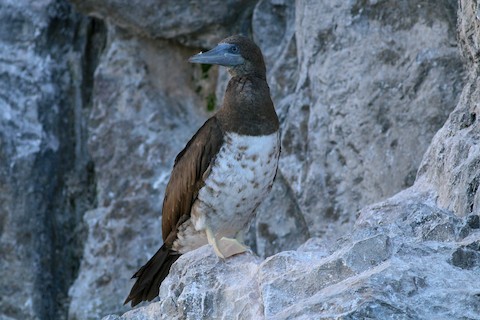
“Brewster’s Booby,” S. l. brewsteri, immature. (Elephant Rock, Nayarit, Mexico; March 31, 2017.) © Skip Russell
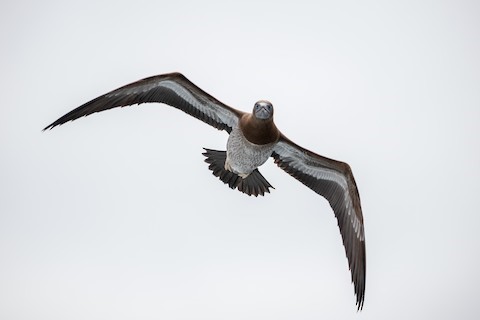
“Brewster’s Booby”, S. l. brewsteri, immature. (Offshore from San Diego, California; March 1, 2019.) © Michael Hilchey
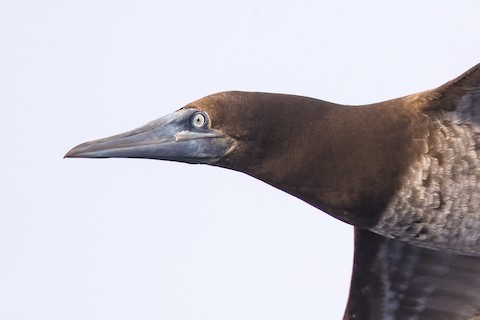
“Brewster’s Booby”, S. l. brewsteri, immature. (Offshore from San Diego, California; October 21, 2018.) © Ryan Sanderson
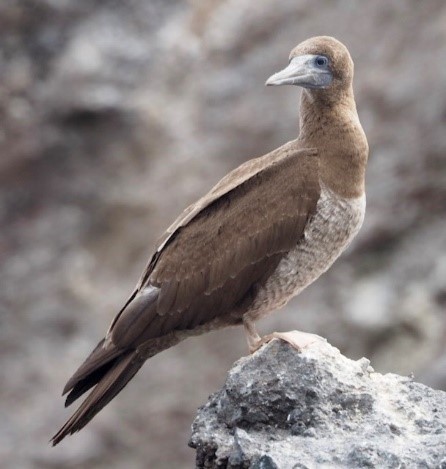
“Brewster’s Booby,” S. l. brewsteri, immature. (Isla Isabel National Park, Nayarit, Mexico; February 8, 2018.) © Rob Worona

“Brewster’s Booby”, S. l. brewsteri, immature female. (Offshore from San Diego, California; September 3, 2018.) © David Pereksta
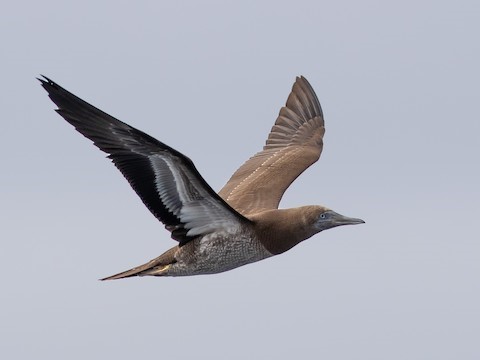
“Brewster’s Booby”, S. l. brewsteri, immature. (Offshore from San Diego, California; March 1, 2019.) © Bruce Aird

“Brewster’s Booby,” S. l. etesiaca, immature. (Manuel Antonio National Park, Quepos, Costa Rica; January 8, 2020.) © Paul Donahue
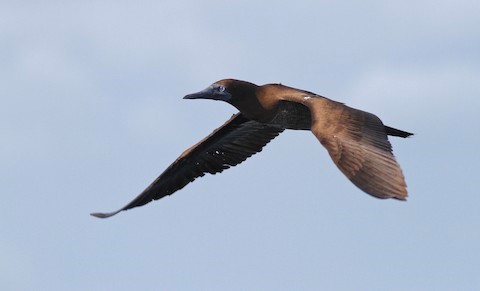
“Brewster’s Booby,” S. l. etesiaca, immature. (Playa Garza, Guanacaste, Costa Rica; December 29, 2017.) © Miles Brengle
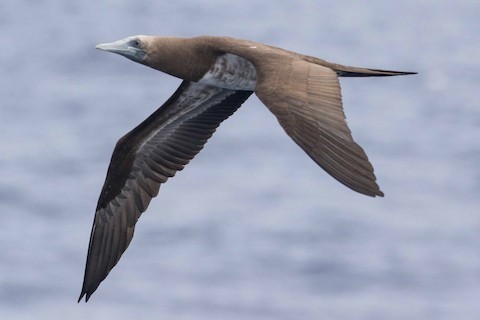
“Brewster’s Booby”, S. l. brewsteri, immature male, far west of its normal range—distinguished from the expected “Forster’s” by pale feathering on the face. (Offshore south of Nihoa Island, Hawaii; April 5, 2018.) © Eric VanderWerf
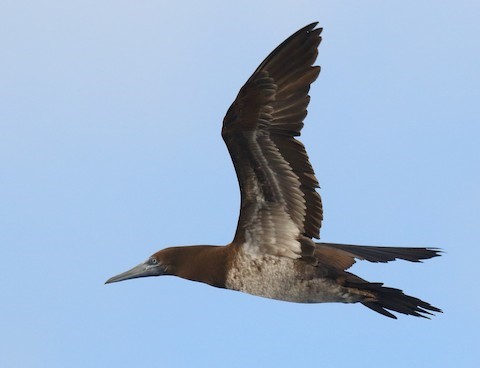
“Brewster’s Booby”, S. l. brewsteri, immature. (Offshore from San Diego, California; October 21, 2018.) © Greg Gillson
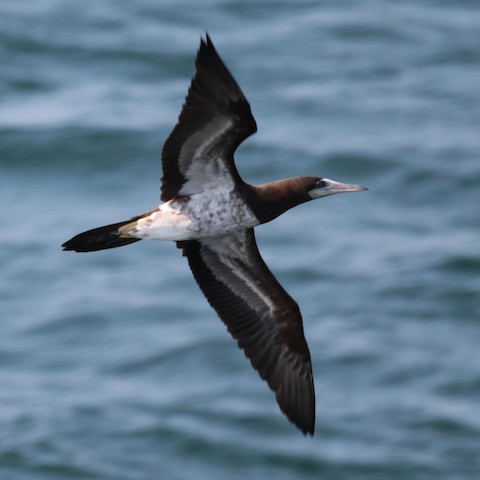
“Brewster’s Booby”, S. l. etesiaca, subadult female. (Gulf of Nicoya, Costa Rica; May 8, 2018.) © Armand Munteanu
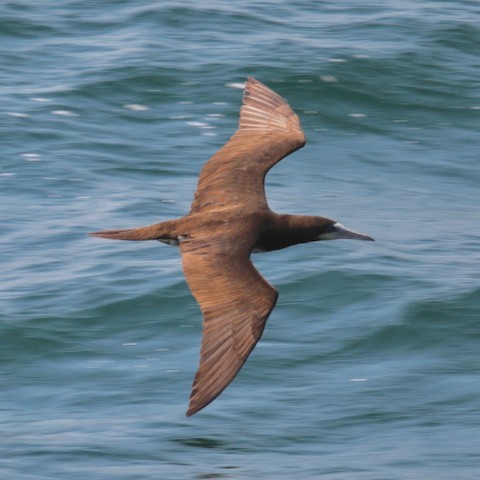
“Brewster’s Booby,” S. l. etesiaca, subadult female. (Gulf of Nicoya, Costa Rica; May 8, 2018.) © Armand Munteanu
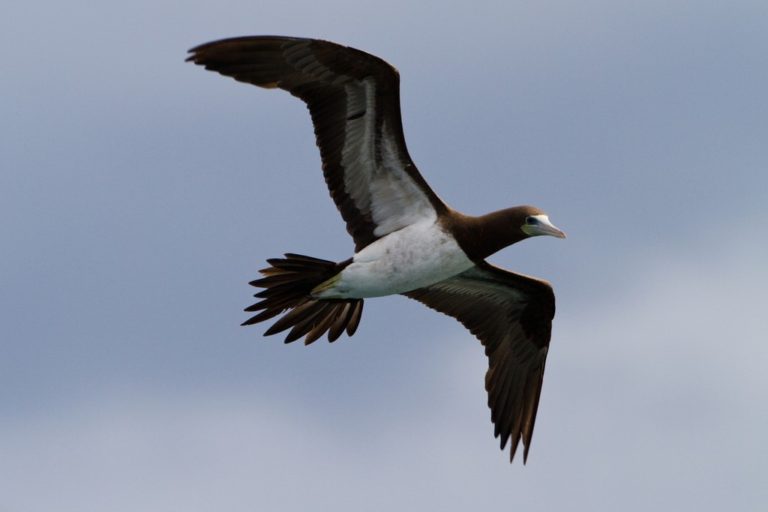
“Brewster’s Booby”, S. l. brewsteri, subadult female. (Offshore from San Diego, California; March 7, 2010.) © BJ Stacey
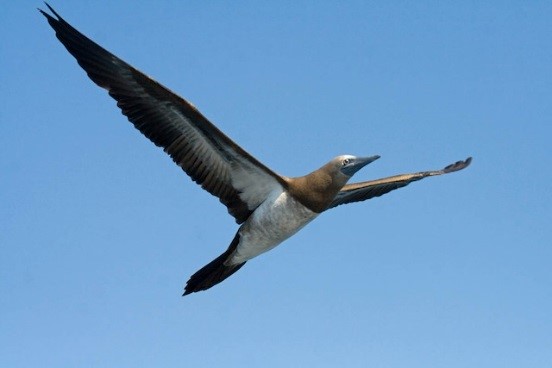
“Brewster’s Booby,” S. l. brewsteri, subadult male. (Nine Mile Bank, offshore from San Diego, California; January 1, 2015.) © Greg Gillson
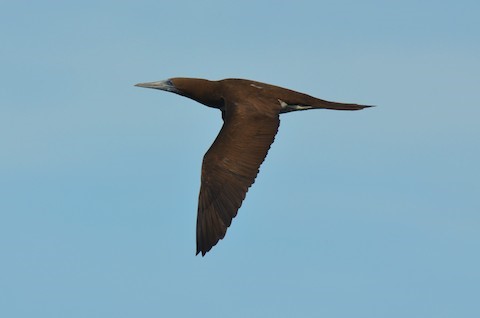
“Brewster’s Booby,” S. l. brewsteri, immature. (Marina Norte de La Paz, Baja California Sur, Mexico; October 3, 2019.) © Jeff Sexton
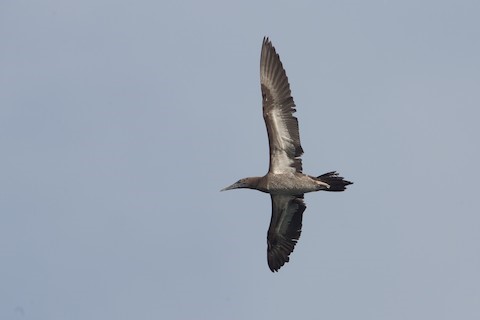
“Brewster’s Booby”, S. l. brewsteri, immature. (Isla Peña Blanca, Colima, Mexico; February 2, 2005.) © Simon Colenutt
Cf. Other Brown Boobies. “Brewster’s” and “Forster’s” Boobies occur together regularly in the central Pacific, mainly in the Hawaiian and Line Islands, and overlap at least occasionally over a large portion of the Pacific Ocean from Japanese to Mexican waters and south into Polynesia. “Atlantic” is not known to have overlapped with either of the others, but all three are highly mobile and habitually rest on ships, so any of them could occur nearly anywhere.
Adult male “Brewster’s” is easily recognized by its pale head, but males of the other two forms and females of all three (especially “Brewster’s” and “Forster’s”) are extremely similar. Immatures appear to be indistinguishable until they begin to show a distinctive aspect of their adult coloration—such as the paler facial plumage of male “Brewster’s” or “Atlantic’s” yellower feet.
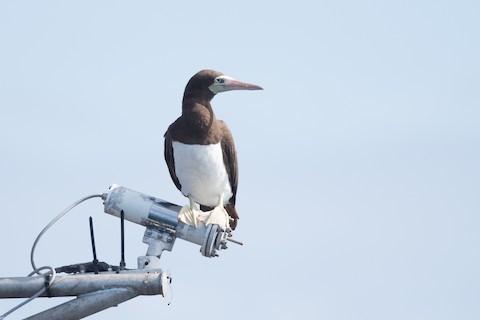
“Brewster’s Booby”, S. l. brewsteri, female, far west of its normal range—identified by thin, pinkish bill and dark portions of underwing coverts not shown here. (35 km offshore from Miyako, Iwate, Honshu, Japan; July 23, 2020.) © Yann Muzika

“Brewster’s Booby”, S. l. brewsteri, immature male, far west of its normal range—distinguished from the expected “Forster’s” by pale feathering on the face. (Offshore south of Nihoa Island, Hawaii; April 5, 2018.) © Eric VanderWerf
Male “Atlantic” and “Forster’s” have approximately the same plumage but are fairly easy to distinguish by the color of their facial skin: orange on “Atlantic” versus dark-blue on “Forster’s”. Their foot color also differs: orangish-yellow on “Atlantic” versus greenish-yellow on “Forster’s”.
Even with clear, high-resolution images, female Brown Boobies are not always assignable to a particular form. The key features are coloration of the bare parts (bill, facial skin, and feet), bill size, and underwing pattern:
Bill Color: Females of all three forms can show a pinkish flush on the bill. “Atlantic” tends to be the pinkest, and “Brewster’s” is also consistently pinkish. “Forster’s” tends to appear more yellowish or ivory than the others, but sometimes has a pinkish hue.
Facial Skin and Foot Color: Females of all three forms have pale-yellow facial skin and feet. “Atlantic” tends to appear closer to pure yellow, whereas “Brewster’s” and “Forster’s” appear closer to white or greenish-yellow.
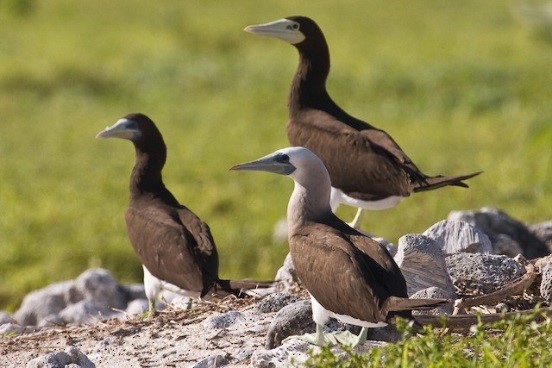
“Forster’s Booby”, S. l. plotus, male and female, with male “Brewster’s Booby”, S. l. brewsteri, male in foreground—note size difference between the large female and both smaller males. (Wake Island; October 24, 2010.) © Eric VanderWerf
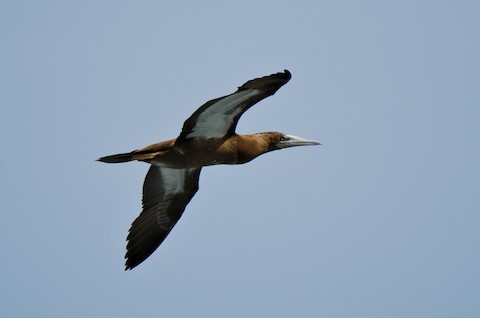
“Forster’s Booby”, S. l. plotus, immature female, showing extensively white underwing coverts, as is typical of this form. (Pauwalu Point, Maui, Hawaii; February 1, 2020.) © Zeke Smith

“Brewster’s Booby”, S. l. brewsteri, immature, showing limited whitish underwing coverts, as is typical of this form. (Isla Peña Blanca, Colima, Mexico; February 2, 2005.) © Simon Colenutt
Bill Size: “Brewster’s” is slightly smaller than the other two and its bill averages somewhat thinner. This difference is probably too slight to be useful, except at the extremes.
Underwing Coverts: On average, “Brewster’s” has more limited white underwing coverts, with a thick brown bar near the wrist and often a dark spur or stripe that projects from the wrist area toward the body. In contrast, “Atlantic” and “Forster’s” usually have almost entirely white underwing coverts. However, all three forms vary to some to extent, and younger birds tend to have more dark covert feathers. The underwing pattern is most useful when the coverts are all-white, because this effectively rules out “Brewster’s”.
Cf. Red-footed Booby. Dark morph Red-footed Boobies, which predominate in some populations—especially in the eastern Pacific—can be all-brown, and the juveniles in particular strongly resemble juvenile and immature Brown Boobies.
Typically, juvenile Brown Boobies are darker than these Red-footeds and more uniformly colored above and below. Immature Browns become distinctive as the belly lightens because the lightened area is sharply defined, matching the adult plumage.
Most juvenile Red-footed Boobies have a perceptibly darker breastband. As they age, dark morph Red-footed Boobies turn coffee-colored rather than dark brown.
Cf. Other Juvenile Boobies. Juvenile Masked, Nazca, and Blue-footed Boobies have roughly the same pattern as adult Brown Boobies, for which they are often mistaken. Under suboptimal viewing conditions they can be indistinguishable, but if seen clearly the crisp bicolored plumage of adult Brown Boobies is unique.
Notes
Polytypic form consisting of two subspecies (brewsteri and etesiaca), one of three distinct forms of Brown Booby (S. leucogaster), sometimes regarded as separate species (e.g., Howell and Zufelt 2019).
References
Alderfer, J., and J.L. Dunn. 2014. National Geographic Complete Birds of North America (Second Edition). National Geographic Society, Washington, D.C.
BirdLife International. 2018. Sula leucogaster. The IUCN Red List of Threatened Species 2018: e.T22696698A132590197. https://dx.doi.org/10.2305/IUCN.UK.2018-2.RLTS.T22696698A132590197.en. (Accessed March 15, 2021.)
eBird. 2021. eBird: An online database of bird distribution and abundance. Cornell Lab of Ornithology, Ithaca, N.Y. http://www.ebird.org. (Accessed March 16, 2021.)
Fagan, J., and O. Komar. 2016. Peterson Field Guide to the Birds of Northern Central America. Houghton Mifflin Harcourt, New York.
Garrigues, R., and R. Dean. 2014. The Birds of Costa Rica: A Field Guide (Second Edition). Cornell University Press.
Harrison, P. 1983. Seabirds: An Identification Guide. Houghton Mifflin, Boston.
Howell, S.N.G., and S. Webb. 1995. A Guide to the Birds of Mexico and Northern Central America. Oxford University Press.
Howell, S.N.G., and K. Zufelt. 2019. Oceanic Birds of the World. Princeton University Press.
McMullan, M., and T. Donegan. 2014, Field Guide to the Birds of Colombia (Second Edition). Fundación Proaves de Colombia, Bogotá.
Pyle, R.L., and P. Pyle. 2017. The Birds of the Hawaiian Islands: Occurrence, History, Distribution, and Status. Version 2 (January 1, 2017). http://hbs.bishopmuseum.org/birds/rlp-monograph/. B.P. Bishop Museum, Honolulu, Hawaii.
Ridgely, R.S., and P.J. Greenfield. 2001. The Birds of Ecuador, Volume II: Field Guide. Cornell University Press.
Ridgely, R.S., and J.A. Gwynne. 1989. A Guide to the Birds of Panama (Second Edition). Princeton University Press.
Schulenberg, T.S., D.F. Stotz, D.F. Lane, J.P. O’Neill, and T.A. Parker. 2007. Birds of Peru. Princeton University Press.
Xeno-Canto. 2021. Brown Booby – Sula leucogaster. https://www.xeno-canto.org/species/Sula-leucogaster. (Accessed March 16, 2021.)
